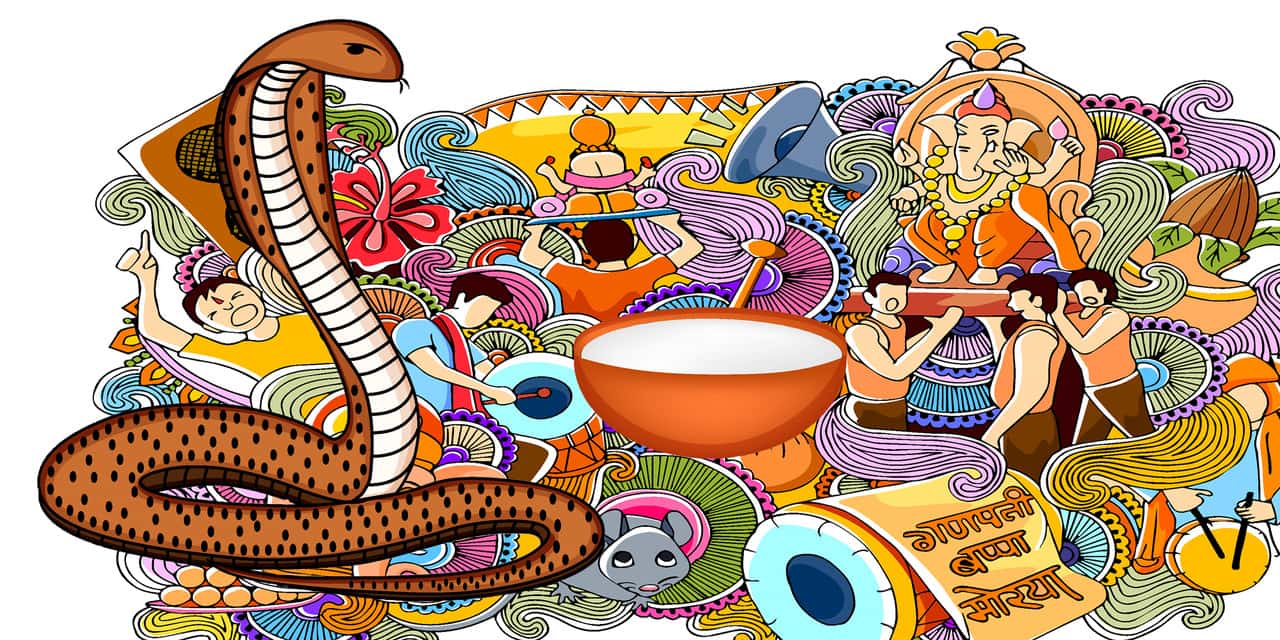
Nag Panchami: The Cultural and Spiritual Significance of Serpent Worship
Nepal’s diverse society and cultural traditions not only honor deities, festivals, and ancestral customs but also show reverence to animals—particularly snakes. Serpent worship holds deep religious, historical, and societal importance.
People believe it expresses faith, devotion, and respect toward nature. Among these traditions, Nag Panchami is a notable festival dedicated to honoring snakes.
On this day, people worship images of serpents and paste them above their doorways with proper rituals. This practice is believed to protect the household from snake-related harm throughout the year. In Hindu belief, snakes are associated with both land and water.
A displeased serpent is thought to bring drought, making snakes symbolic rulers of rain and water. Because of this, Nag worship is performed when laying house foundations and during Nag Panchami to ensure timely rain and avoid flood-related disasters.
Hindu Belief and Mythological Roots of Serpent Worship
In Hindu tradition, serpents have been revered as Vedic deities. Lord Shiva wears snakes as garlands, and Lord Vishnu rests on the multi-hooded serpent Sheshnag, floating over the cosmic ocean. Ancient seals from the Indus Valley Civilization depict snake-worshipping priests, suggesting its long-standing presence in South Asian history.
In one depiction found on a talisman, a serpent is shown resting over Vedic scriptures, symbolizing its sacred role. This evidence supports the belief that serpent worship has ancient roots that date back to early human civilization.
The Kathmandu Valley and the Myth of Nag Settlements
Historical texts mention that the Kathmandu Valley was once a vast lake, inhabited by serpents. The legend of Manjushree cutting the gorge to drain the lake and make the land habitable includes references to Nagas residing in the water.
Sheshnag is considered the divine incarnation of Balram, brother of Krishna, and also of Lakshman, brother of Ram. Stories mention Krishna subduing the fierce serpent Kaliya during his childhood.
One particular story links the origin of Nag Panchami to an incident involving a farmer who unknowingly killed three baby snakes while plowing his field.
Their mother, enraged, killed the farmer and his family. However, the daughter, who was away, offered milk and begged for forgiveness. The snake, appeased, granted her life and even offered to revive her family. Since then, Nag Panchami has been celebrated in memory of that event.
Mythological References and the Power of Serpent Worship
Numerous religious texts highlight the significance of serpent worship. According to ancient beliefs, worshipping Nagas and offering them milk brings prosperity and protection from untimely death due to snakebite.
The Varaha Purana mentions that from the union of Kashyap and Kadru, several serpent deities such as Ananta, Vasuki, Padma, Mahapadma, Kambala, Karkotaka, and Shankha were born.
Hindus believe that Nagas guard buried treasures beneath the earth and bestow wealth only upon those who appease them. They also play a role in bringing rain, calming storms, and balancing fire and water elements.
A tale from the Panchatantra describes a generous snake who gave a gold coin daily to a Brahmin. One day, the Brahmin’s greedy son tried to kill the snake to take all the gold at once, but was fatally bitten. From that day, the serpent ceased its offerings, demonstrating its divine authority and reminding people not to exploit nature.
The Twelve Prominent Serpent Deities
Twelve well-known serpent deities are mentioned in sacred texts:
-
Ananta
-
Vasuki
-
Padma
-
Shesha
-
Kaliya
-
Karkotaka
-
Ashvatara
-
Takshaka
-
Pingala
-
Shankha
-
Goman
-
Mahapadma
Each of these Nagas is associated with specific water bodies, and it is believed that each lake or pond houses its own serpent deity.
Associated Legends: From Garuda Conflicts to Janamejaya's Sacrifice
Several stories further enrich serpent mythology. One legend speaks of a conflict between Nagas and Garuda (the eagle), while another recounts King Janamejaya’s serpent sacrifice (Nag Yagya) to avenge his father’s death. Hindu philosophy, however, emphasizes respecting all beings—including serpents.
Lord Vishnu, known as the preserver of life, is shown resting peacefully upon a serpent, symbolizing universal harmony.
During Lord Krishna’s birth, Nagas shielded him from rain while crossing the Yamuna River, reinforcing their role as protectors. Likewise, Lord Shiva is always adorned with snakes, representing fearlessness and cosmic balance.
Sage Gorakhnath is said to have meditated on nine serpent thrones for twelve years. Ancient texts also state that the most precious gem, the Mani, rests on the forehead of the supreme Nagas.
The Vedas, Puranas, and Upanishads all reference serpents with reverence, and Sheshnag is even said to support the entire Earth on his hood.
Astrological and Agricultural Significance
According to Vedic astrology, performing rituals for snake deities on Nag Panchami helps neutralize the Kaal Sarp Dosh and ward off related health issues. There is also a common belief that plowing fields on this day should be avoided to prevent harming snakes.
People draw multicolored serpent figures and place them at entrances with cow dung, symbolizing protection. In rural areas, snakes made from rice flour are offered worship at water sources and temples. Major water bodies like Nag Pokhari in Kathmandu and Siddha Pokhari in Bhaktapur see large gatherings for worship on this day.
Embracing Nature Through Cultural Harmony
Serpent worship during Nag Panchami represents more than myth and religion—it reflects Nepal’s deep-rooted respect for all living beings. This celebration not only bridges the natural and spiritual worlds but also reinforces the values of coexistence, gratitude, and environmental harmony that define Nepalese tradition.
By acknowledging even the smallest creatures in nature through rituals and stories, Nepali culture embraces a holistic view of the universe—where every being, from humans to serpents, has its place and purpose.


